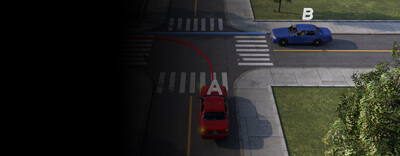U.S. Driving Tests for Foreign Nationals and New Arrivals
State-specific questions
Questions almost exactly like the ones on the official DMV test


Questions almost exactly like the ones on the official DMV test



If you’ve spent any time in the U.S., you know how much we depend on car travel. In some places, not having a driver’s license can significantly limit your activities. That’s why many newcomers will want to obtain a driver’s license as soon as possible. In many cases, you’ll also be able to use your license as an ID. State-issued driver’s licenses are the primary identity document in the United States and are often used as photo IDs. You may need a photo ID in many different scenarios, such as when purchasing alcohol.
A newcomer might be able to exchange a home country license for a U.S. license, but others will be required to test for their licenses. There are two tests required to earn your driver’s license in all 50 states—the written exam and the road test. Find out more below.
The written exam, or knowledge test, is a computerized test based on your state's DMV handbook. Many states will require you to pass this exam before moving on to the road test. Even if you have a foreign license, you may still be required to take the written exam in order to ensure you're familiar with U.S. driving customs and road laws.
Although learning new driving laws and customs can be intimidating, newcomers have many resources, including our practice exams. For most drivers, the written exam only has to be passed once for the entirety of their driving years.
The road test will put you behind the wheel, with an evaluator in the passenger seat. It is intended to assess your ability to safely operate a vehicle and follow state driving laws. The test typically takes place in the parking lot and on streets surrounding the DMV building.
All U.S. states require an applicant to pass a road test before being issued a license. However, some states will waive the DMV road test if you already hold a driver's license issued by certain foreign countries.
As mentioned above, driver's licenses are not issued by the federal government, but by the state in which you reside. Different states will require different qualifying documents, as will your status. For example, if you are a visiting student, you'll likely have to present your student visa, passport, proof of residency, and in some states, a social security card. Requirements would be different for Green Card holders or someone with a fiance visa, for instance. Check with your state's DMV to find out which documents you'll need or use our DMV Assistant.
In most cases, people with a pending green card status will be able to get a U.S. driver's license. You'll need to provide proof of pending status, your passport, and proof of residency in the state. Keep in mind that most states will not issue licenses that exceed the expiration date on your residency status documents.
In many states, you are required to have a Social Security Number before you are able to get your license. Some states accept Individual Tax Identification Numbers as a substitute. Check with your state's DMV.
Most states allow you to drive on a foreign license for up to three months, as long as it is accompanied by your passport. If you want to rent a car, you might need an international license, depending on the rental company. International licenses are typically good for one year of driving in the U.S.
This depends on what state you're in and whether your home country provides driver's license reciprocity for the state. In some cases, you'll simply need to exchange your foreign license and present the necessary identification and residency documents. In other cases, you'll be required to take the written and/or road test.
But rest assured, we have free practice tests to help you pass the written portion of the exam. Start studying today so you can start driving in the U.S.
Сheck out our free driving tests to help you pass the official DMV written exam.
Select your state